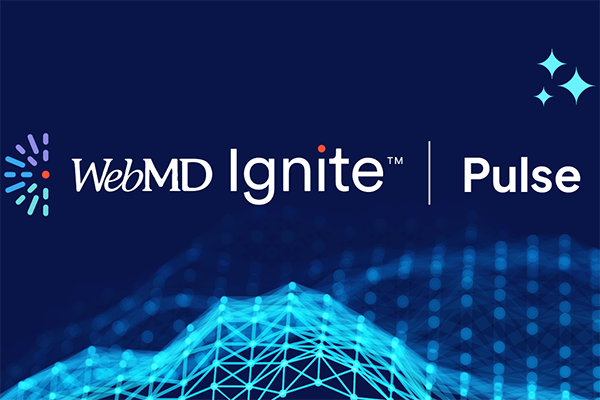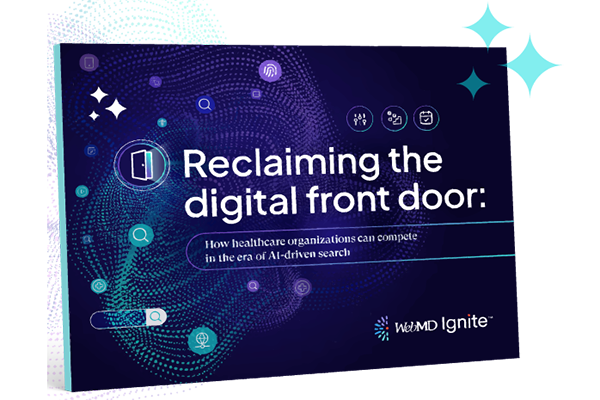Healthcare big data FAQ

Editor's Note: This blog was published prior to the transition to WebMD Ignite.
Frequently asked questions: What is healthcare big data?
Healthcare big data refers to collecting, analyzing, and leveraging consumer, patient, physical, and clinical data that is too vast or complex to be understood by traditional means of data processing. Instead, big data is often processed by machine learning algorithms and data scientists.
The rise of healthcare big data comes in response to the digitization of healthcare information and the rise of value-based care, which has encouraged the industry to use data analytics to make strategic business decisions. Faced with the challenges of healthcare data – such as volume, velocity, variety, and veracity – health systems need to adopt technology capable of collecting, storing, and analyzing this information to produce actionable insights.
Benefits of big data in healthcare
- Create a holistic, 360-degree view of consumers, patients, and physicians.
- Improve care personalization and efficiency with comprehensive patient profiles.
- Identify geographic markets with a high potential for growth.
- Inform physician relationship management efforts by tracking physician preferences, referrals, and clinical appointment data.
- Boost healthcare marketing efforts with information about consumer, patient, and physician needs and preferences.
- Provide straightforward identification of patterns in health outcomes, patient satisfaction, and hospital growth.
- Optimize hospital growth by improving care efficiency, effectiveness, and personalization.
Common questions about big data in healthcare
Why is big data important for healthcare?
Big data has become more influential in healthcare due to three major shifts in the healthcare industry: the vast amount of data available, growing healthcare costs, and a focus on consumerism. Big data enables health systems to turn these challenges into opportunities to provide personalized patient journeys and quality care.
- Increasing Volume of Healthcare Data: When health records went digital, the amount of virtual data health systems had to handle rose steeply. In addition to EHRs, vast amounts of data are sourced in other ways – through wearable technology, mobile applications, digital marketing efforts, social media, and more. All of this adds up to an incredible amount of information, spurring health systems to adopt big data systems and technologies to effectively collect, analyze, and take advantage of this information.
- Growing Healthcare Costs: In the past 20 years, the United States has seen rapid growth in healthcare costs. Today, healthcare expenses account for around 18 percent of GDP, totaling about $3.4 trillion. This is partially due to lifestyle factors, as well as government regulations. Through the collection and analysis of large amounts of data, healthcare organizations will find quantifiable ways to improve performance and efficiency. This promotes both increased patient satisfaction and your ability to capture greater market share.
- Desire for Personalized Care: Consumers in all industries expect exceptional, convenient, personalized service – a phenomenon that retail industry executives have dubbed “The Amazon Experience.” Healthcare is no different. Customers want convenient, personalized care, a new standard to which health systems must rise. This new model of care focuses on quality, engagement, and retention. Health systems are turning to healthcare big data to provide the insights necessary to drive this level of personalization.
How can big data accelerate growth initiatives?
Big data fuels the creation of propensity models, which improves marketing outreach and guides best next action discovery pathways.
Propensity models are a subset of big data statistical analysis used to predict the likelihood of a specific event to occur. Marketing departments can use propensity models to score potential targets and identify those most likely to respond to specific campaigns and messaging. With more accurate campaign targeting, marketers are able to improve response rates and reduce wasted spend.
Guided discovery pathways allow healthcare marketers to evaluate market dynamics without needing to identify a particular service line. Marketing teams can highlight valuable opportunities by integrating diverse information regarding geographies, physicians, and patients – resulting in a high potential for growth.
Communication personalization is a critical initiative for healthcare marketers in a value-based care landscape. By leveraging a sizable collection of consumer and patient information, marketers create well-informed personalized marketing messages. When health systems engage in relevant and personalized communication, customers are more likely to form and continue an ongoing relationship with their system.
Integrated communication helps create holistic customer experiences throughout the care continuum. Big data is critical for transforming marketing communication platforms – including call centers, email, patient portals, and more – into strategic engagement entities. For example, call center representatives with easy access to customer and patient data are able to conduct informed and personalized conversations based on their previous interactions with the health system. The result of creating holistic experiences across care touchpoints is improved customer engagement and satisfaction.
What challenges arise with big data in healthcare?
A major challenge with healthcare big data is sorting and prioritizing information. Data capacities are so vast that oftentimes it can be difficult to determine which data points and insights are useful. As a result, many organizations use AI or machine learning to process this data with exceptional agility.
Another challenge is ensuring that the right access to big data insights and analysis is given to the right people so they can work intelligently. Even though healthcare data is pulled from many different systems, organizations need to make sure critical personnel across the industry have comprehensive access to the information. There are also a number of data analysis challenges that result from heterogeneous or missing claims data. The complexity of data is further compounded by each healthcare institution filing claims with data from other Hospital Information Systems (HIS), or input from hospital personnel at the time of the encounter. The data becomes even more complex when factoring in all the ambulatory places or service types. As a result, there are five challenges to overcome in order to obtain accurate claims data:
- Billing systems are fragmented and dated – Data is often very “noisy” – practices, groups, and even service line specialties can be inconsistent. The key is to consider directional data in combination with your local geographic market knowledge; in other words, data should augment interactions and focused outreach to physicians, not replace it.
- Patients do not have unique patient identifiers – If every patient had a unique identifier, data matching would not be required. Until that happens, data matching mechanisms are required to look for these data anomalies and put the right patient claims together.
- Diagnosis and procedure codes can be unclear – Even industry-standard grouper tools can obscure or mis-map physician activity. Perfect data and perfect insights are very hard to achieve, so you have to advocate for, and learn to work with, directional data.
- Claims data is highly inconsistent – With claims data, any field data that is not required for payment has a low probability of being completed accurately. In fact, among the few required fields for payment, along with patient, diagnosis, and procedure information, is the “rendering physician” via the NPI1 for that provider.
- It’s difficult to identify the referring physician – The “referring physician” field on available third-party claims is often inconsistent, incorrect, or not filled at all. In fact, some clearinghouses don’t even provide the “referring physician” field because of these inconsistencies.
What is the future of big data in healthcare?
In the future, healthcare organizations will adopt big data in greater numbers as it becomes more crucial for success. Healthcare big data will also continue to help make marketing touchpoints smarter and more integrated. Additionally, the amount of data available will grow as wearable technology and the Internet of Things (IoT) gains popularity. Constant patient monitoring via wearable technology and the IoT will become standard and will add enormous amounts of information to big data stores. With this information, healthcare marketers can integrate a large volume of healthcare insights to find and retain patients with the highest propensity for services.




